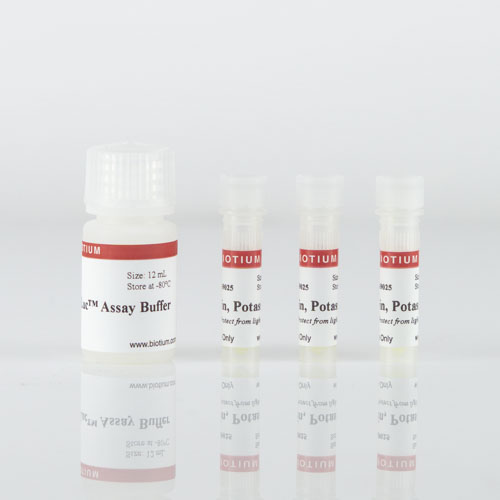Steady-Luc™ Firefly HTS Assay Kit
A homogeneous firefly luciferase reporter gene assay kit with a luminescence half-life of about 3 hours, allowing batch processing in microplates.
Please fill in the inquiry form and we will contact you shortly.
Wishlist updated! View wishlist
Product Description
The Steady-Luc™ HTS assay system is a homogeneous, high-sensitivity firefly luciferase reporter gene assay kit. It is a glow-type assay with signal half-life of about 3 hours, allowing batch processing in microplates.
Features
- Simple, single step homogeneous assay
- Luminescence half life of about 3 hours
- Great value: save up to 45% compared to other brands
Kit Components
- D-Luciferin
- Steady-Luc™ Firefly Assay Buffer
Firefly luciferase is widely used as a reporter for studying gene regulation and function, and for pharmaceutical screening. It is a very sensitive genetic reporter due to the lack of endogenous activity in mammalian cells or tissues. However, the light production resulting from the reaction leads to formation of suicidal adenyl-oxyluciferin at the enzyme surface. It results in very short half-life of the light emission with a flash-type kinetics. Because of this, flash-type luminescence must be detected immediately after initiating the reaction, which is not compatible with batch analysis of samples.
Biotium’s Steady-Luc™ Firefly Assay Buffer contains a proprietary mixture of substances that prevent the adenyl-oxyluciferin reaction, producing a long lasting, glow-type signal. It produces luminescence signal with a half-life of about 3 hours, for a high-throughput microplate assay.
Glow-type luciferase assays like Steady-Luc™ have lower luminescence signal compared to flash-type assays. The sensitivity and limit of detection of the assay will depend on luciferase expression levels in your experimental system as well as luminometer sensitivity.
Biotium also offers Steady-Luc™ Firefly HTS Assay Kit (Lyophilized) (catalog no. 30028L), a new packaging format that includes lyophilized assay buffer for convenient room temperature shipping and storage at -20°C.
More Luciferase Kits & Related Products
| Biotium Cat. No. | Product | Description | Promega Assay | Promega Cat. No. |
|---|---|---|---|---|
| 30138 | Steady-ATP™ HTS Viability Assay Kit | Highly sensitive ATP-based cell luminescent viability assay with signal half-life of 5 hours for high-throughput screening in multi-well plates. | CellTiter-Glo® Luminescent Cell Viability Assay | G7570, G7571, G7572, G7573 |
| 30085 | Firefly Luciferase Assay Kit 2.0 | Flash-type firefly luciferase assay kit. | Firefly Luciferase Assay System | E1483, E1500, E1501, E4030, E4530, E4550 |
| 30075 | Firefly Luciferase Assay Kit (Lyophilized) | Firefly luciferase assay kit with lyophilized assay buffer for economical room temperature shipping and convenient storage at -20°C. | ||
| 30028 | Steady-Luc™ Firefly HTS Assay Kit | Glow-type firefly luciferase assay with signal half-life of about 3 hours for high-throughput screening in multi-well plates. | Steady-Glo® Assay System | E2510, E2520, E2550 |
| 30028L | Steady-Luc Firefly HTS Assay Kit (Lyophilized) | Steady-Luc kit with lyophilized assay buffer for economical room temperature shipping and convenient storage at -20°C. | ||
| 30082 | Renilla Luciferase Assay Kit 2.0 | Flash-type Renilla luciferase assay kit. | Renilla Luciferase Assay System | E2810, E2820 |
| 30081 | Firefly and Renilla Luciferase Single Tube Assay Kit | Assay kit for measuring firefly and Renilla activities sequentially in the same sample in a single tube. | Dual-Luciferase® Assay System (Firefly & Renilla) | E1910, E1960, E1980 |

